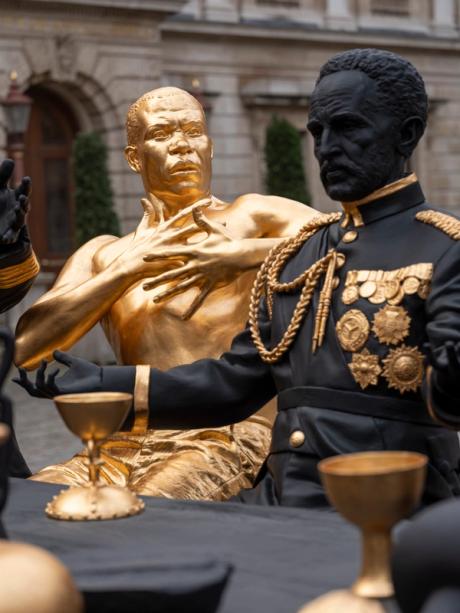
One of London’s most striking public art works has been unveiled in the courtyard of the Royal Academy of Arts (RA) in London. Bahamian artist Tavares Strachan’s 21st-century version of Leonardo da Vinci’s The Last Supper (around 1515)—entitled The First Supper (Galaxy Black), 2023—greets visitors to the RA, welcoming them to the latest blockbuster exhibition Entangled Pasts 1768-now: Art, Colonialism and Change (3 February-28 April).Strachan’s piece—crafted from bronze, black patina and gold leaf—is a “monument to the singular contributions of 12 Black figures from the 17th century to the present day… they have in common histories of overcoming power structures designed to keep them oppressed”, writes the art historian Alayo Akinkugbe in the exhibition catalogue.Figures depicted include Sister Rosetta Tharpe, the queer gospel singer of the 1930s; Shirley Chisholm, the first Black woman elected to the US Congress; the 19th-century abolitionist Harriet Tubman and Marsha P. Johnson, a key figure in the Stonewall uprising of 1969 in New York.”In the context of sculpture, I think it’s important for us to have an archive of the stories of our folks” Strachan saysPhoto: Royal Academy of Arts, LondonStrachan himself is depicted in a self-portrait “in which he assumes the role of Judas.” Akinkugbe says. “But rather than betraying the messiah, Strachan betrays history’s status quo by bringing to light these marginalised figures in a composition that is typically associated with Christ and his disciples.” The catalogue also points out also that a large-scale painted copy of Leonardo’s mural, made around 20 years after the original, is in the collection of the Royal Academy.Strachan says in the catalogue: “In the context of sculpture, I think it’s important for us to have an archive of the stories of our folks; one that doesn’t necessarily centre Europe, Modernism or any -ism that is not indicative of us.” “There are different kinds of monuments in the show,” says the exhibition curator Dorothy Price, who adds that the “monument issue was really one of the major contexts for doing Entangled Pasts 1768-now [along with] the role of art in imperial histories”. Price also highlights other pieces that subvert the traditional idea of a monument: Olu Ogunnaike’s I’d Rather Stand (2022) and Justice for All (2019) by Yinka Shonibare.Strachan himself is depicted in a self-portrait “in which he assumes the role of Judas.”Photo: Royal Academy of Arts, LondonThe toppling of the statue of slave trader Edward Colston in 2020 in Bristol, UK, was one of the motivations behind the show. When the sculpture was brought down, “the reverberations were keenly felt around the world. For those willing to listen, however, debates around the moral bankruptcy of many public monuments had been raging for decades”, Price writes in the catalogue, referencing Hew Locke’s 2006 piece Colston (Restoration Series).The show brings together more than 100 works which throw light on “narratives of empire, enslavement, resistance, abolition, indenture and colonialism”, a Royal Academy text says. Other artists featured include Joshua Reynolds, Sonia Boyce, Benjamin West, Isaac Julien and Barbara Walker.




















